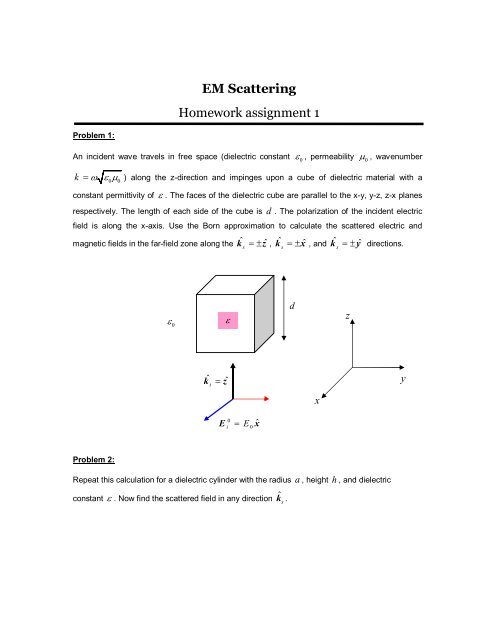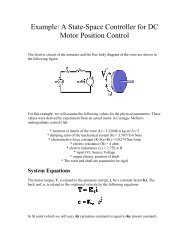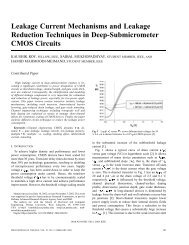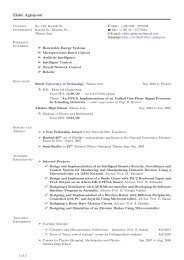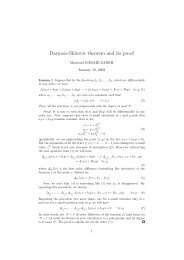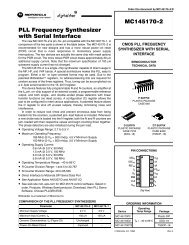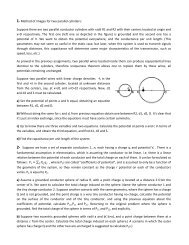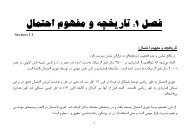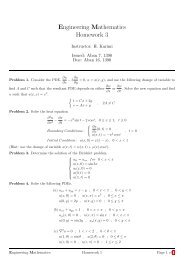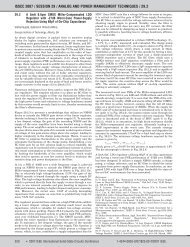EM Scattering Homework assignment 1
EM Scattering Homework assignment 1
EM Scattering Homework assignment 1
Create successful ePaper yourself
Turn your PDF publications into a flip-book with our unique Google optimized e-Paper software.
<strong>EM</strong> <strong>Scattering</strong><br />
<strong>Homework</strong> <strong>assignment</strong> 1<br />
Problem 1:<br />
An incident wave travels in free space (dielectric constant <br />
0<br />
, permeability <br />
0<br />
, wavenumber<br />
k<br />
) along the z-direction and impinges upon a cube of dielectric material with a<br />
0 0<br />
constant permittivity of . The faces of the dielectric cube are parallel to the x-y, y-z, z-x planes<br />
respectively. The length of each side of the cube is d . The polarization of the incident electric<br />
field is along the x-axis. Use the Born approximation to calculate the scattered electric and<br />
magnetic fields in the far-field zone along the k ˆ z<br />
ˆ<br />
s , k ˆ x<br />
ˆ<br />
s , and k ˆ y<br />
ˆ<br />
s directions.<br />
<br />
0<br />
<br />
d<br />
z<br />
kˆ<br />
i<br />
z ˆ<br />
y<br />
x<br />
0<br />
E<br />
i<br />
E ˆ 0<br />
x<br />
Problem 2:<br />
Repeat this calculation for a dielectric cylinder with the radius a , height h , and dielectric<br />
constant . Now find the scattered field in any direction k ˆs .
0<br />
<br />
h<br />
z<br />
2a<br />
y<br />
kˆ<br />
i<br />
z ˆ<br />
x<br />
0<br />
E<br />
i<br />
E ˆ 0<br />
x<br />
Problem 3:<br />
E r E exp 0<br />
ki<br />
r where k<br />
i<br />
is the<br />
i<br />
i<br />
Consider a plane wave traveling in free space with j <br />
incident wave vector with k<br />
i<br />
k 00<br />
. The wave is incident upon a certain dielectric<br />
object of arbitrary shape with a dielectric constant<br />
r generating equivalent currents inside<br />
the object. Let E , H denote the scattered field, i.e., the field induced by these equivalent<br />
s<br />
s<br />
currents. In the far field zone the scattered electric field is given by:<br />
Where,<br />
ˆs<br />
<br />
f<br />
exp jkr<br />
E ( ) <br />
ˆ , ˆ<br />
s<br />
r Q<br />
<br />
k<br />
s<br />
k<br />
i<br />
r<br />
k denotes the direction of scattering and <br />
ˆ ˆ<br />
s<br />
,<br />
i <br />
<br />
<br />
Q k k is the vector scattering amplitude<br />
(see the powerpoint slides for a description). Using the reciprocity theorem of electromagnetic<br />
theory show that<br />
i<br />
<br />
ˆ ˆ k<br />
<br />
i<br />
E0 Q , ˆ<br />
<br />
ki ki E0<br />
<br />
s <br />
exp j<br />
i<br />
dS<br />
<br />
4<br />
j<br />
<br />
n E r k r<br />
S<br />
i<br />
0<br />
<br />
ˆ exp j <br />
H H r n k r<br />
<br />
dS<br />
<br />
s i <br />
S
i<br />
Where 1/<br />
<br />
ˆ<br />
i<br />
H0 ki<br />
E<br />
0<br />
, 0 / 0<br />
the object. (See figure below)<br />
, and S is any arbitrary closed surface surrounding<br />
k<br />
ˆi<br />
r<br />
<br />
S


